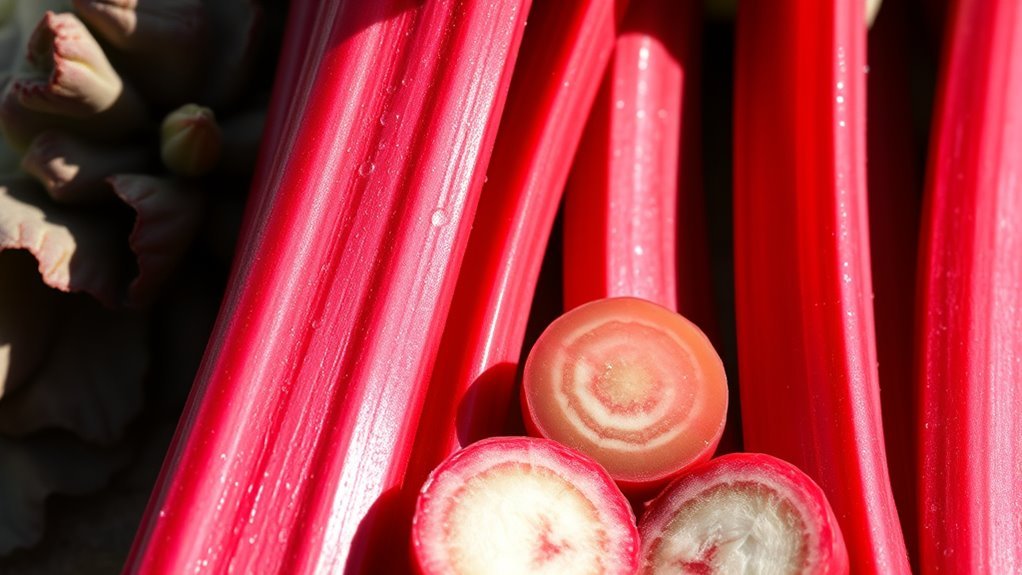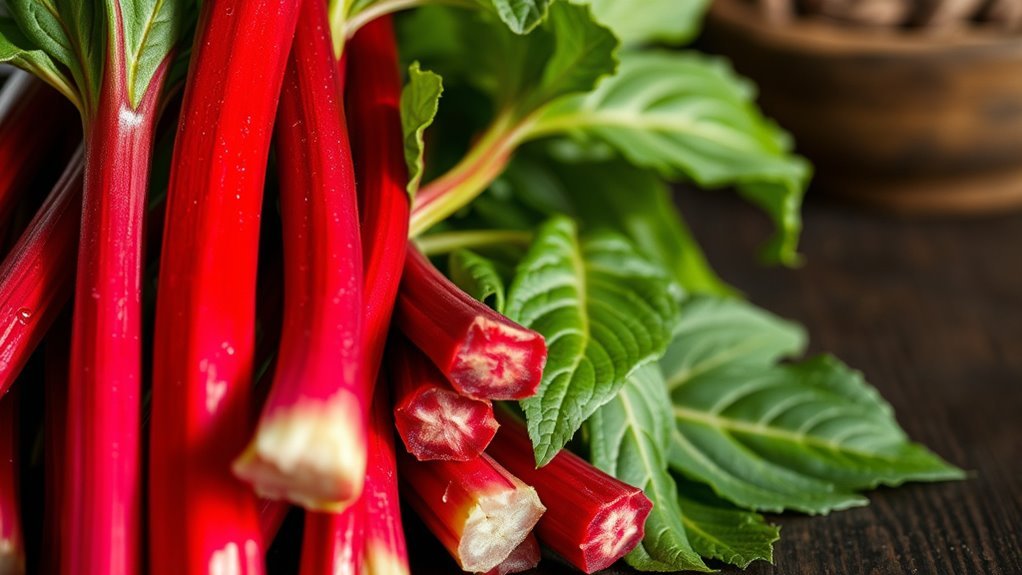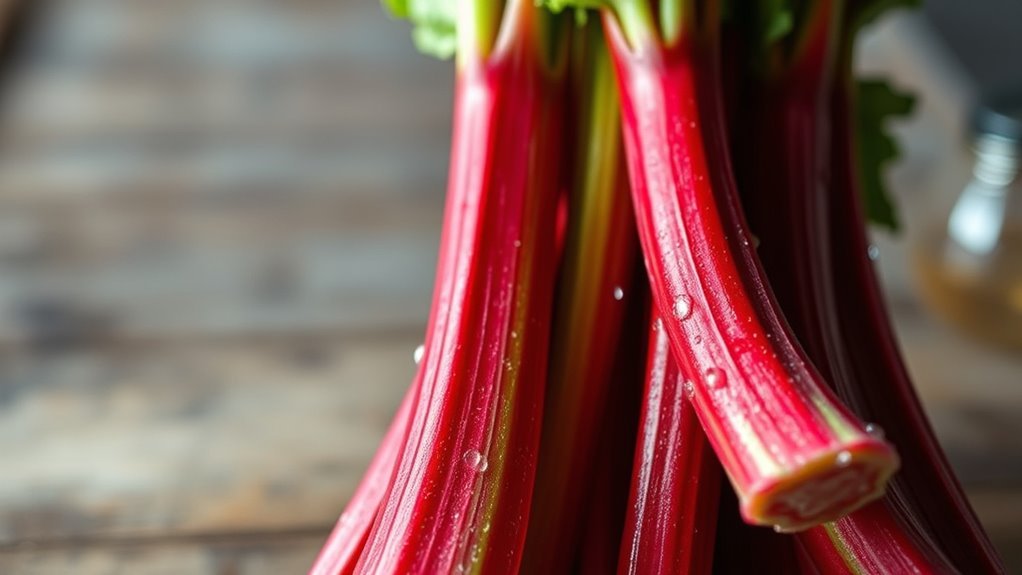Yes, rhubarb is keto-friendly due to its low carbohydrate content, containing only 5.0g of net carbs per 100g. This makes it a great option for those keeping a ketogenic diet. It’s low in calories and high in fiber, which can promote digestive health. However, it has limited nutritional value and high oxalate levels, which may affect some individuals. To learn how to prepare delicious rhubarb dishes or discover potential drawbacks, keep exploring!
Understanding Rhubarb: A Brief Overview

Rhubarb, often mistaken for a fruit, is actually a vegetable known for its tart flavor and vibrant red stalks. There are several rhubarb varieties, including the common garden rhubarb and the sweeter, more tender varieties like Victoria. Each type presents unique culinary uses, making rhubarb a versatile ingredient. You can incorporate it into pies, jams, or even savory dishes, where its acidity can balance rich flavors. Its tartness shines when paired with sweetness, offering an invigorating contrast in desserts. When considering your culinary creations, think about how different rhubarb varieties can enhance your dishes. By exploring these options, you can find the perfect rhubarb to suit your taste and elevate your meals, embodying the freedom to experiment in your kitchen.
Nutritional Profile of Rhubarb

When considering rhubarb’s fit in a keto diet, it’s essential to look at its carbohydrate content and nutritional benefits. You’ll find that rhubarb is low in carbs, making it a suitable option for those managing their carbohydrate intake. Additionally, it boasts vitamins and minerals that can enhance your overall health while following a ketogenic lifestyle.
Carbohydrate Content Analysis
Although often mistaken for a fruit, rhubarb is a vegetable that boasts a surprisingly low carbohydrate content, making it an appealing choice for those following a keto diet. Let’s break down the carbohydrate profile of this versatile plant, which comes in various rhubarb varieties, each with unique flavors and textures.
| Nutrient | Amount per 100g |
|---|---|
| Total Carbohydrates | 7.0g |
| Dietary Fiber | 2.0g |
| Net Carbs | 5.0g |
| Sugars | 1.0g |
Rhubarb cultivation is straightforward, and its low carb content makes it a smart addition to your meals. Enjoy it in moderation and reap the benefits while staying in ketosis!
Vitamin and Mineral Benefits
Beyond its low carbohydrate content, rhubarb offers a range of vitamins and minerals that can enhance your nutritional intake. One of the notable rhubarb benefits is its impressive vitamin K content, essential for bone health and proper blood clotting. Additionally, rhubarb provides vitamin C, which supports immune function and skin health. You’ll also find small amounts of B vitamins, like folate, contributing to energy production and cellular health. Its mineral content includes potassium, which helps regulate blood pressure, and calcium, important for bone density. By incorporating rhubarb into your diet, you’re not just enjoying a delicious tart flavor; you’re also enriching your body with crucial nutrients that support overall well-being. This aligns perfectly with a keto-friendly lifestyle focused on health.
Carb Content of Rhubarb

Rhubarb contains about 4 grams of carbohydrates per 100 grams, making it a relatively low-carb option for those following a ketogenic diet. This low carb content applies to various rhubarb varieties, allowing you to enjoy this tart vegetable without derailing your keto goals. When considering rhubarb storage, it is crucial to keep it in the refrigerator, ideally wrapped in a damp cloth or paper towel, to maintain its freshness and minimize carbohydrate degradation. Remember, the way you prepare rhubarb can impact its carb content; for instance, adding sugar or other high-carb ingredients can increase the overall carbohydrate count. So, if you’re looking for a keto-friendly vegetable, rhubarb is a solid choice that offers versatility and low carb satisfaction.
Health Benefits of Rhubarb
While enjoying rhubarb for its low carbohydrate content, it’s worth noting the various health benefits it offers. Rhubarb health is more than just a low-calorie option; it’s packed with nutrients that support your well-being.
Rhubarb is not only low in carbs but also rich in nutrients that enhance your overall health.
- Rich in antioxidants, helping to combat oxidative stress.
- High in fiber, promoting digestive health and satiety.
- Contains vitamins K and C, essential for bone health and immunity.
Incorporating rhubarb into your diet can provide these rhubarb benefits, empowering you to maintain a balanced lifestyle. With its unique flavor and nutritional profile, rhubarb isn’t just a tasty addition; it’s a natural ally in your pursuit of health. Embrace the freedom to enjoy this versatile plant while reaping its diverse health rewards!
How to Prepare Rhubarb for Keto Meals
When preparing rhubarb for keto meals, it’s essential to evaluate a few key techniques to maximize its flavor while keeping your carbohydrate intake low. Start by choosing fresh, vibrant stalks, as these yield the best taste. A popular cooking technique is sautéing; by quickly cooking rhubarb with a bit of butter or coconut oil, you can enhance its natural tartness. For flavor pairings, consider mixing rhubarb with low-carb sweeteners like erythritol or stevia to balance its acidity. You can also combine it with spices like cinnamon or ginger, which add depth without increasing carbs. Experimenting with these methods not only preserves rhubarb’s unique flavor but also fits seamlessly into your keto lifestyle.
Delicious Keto-Friendly Rhubarb Recipes
If you’re looking to incorporate rhubarb into your keto meal plan, you’ll be pleased to know there are numerous delicious recipes that highlight its unique flavor while keeping carbs in check. Here are a few ideas to inspire you:
- Keto Rhubarb Crisp – A satisfying dessert, using almond flour and erythritol for sweetness without the carbs.
- Savory Rhubarb Chicken – A surprising yet delightful pairing that balances savory spices and tangy rhubarb for a unique main dish.
- Rhubarb Chia Pudding – A revitalizing and nutritious breakfast option that combines rhubarb with chia seeds for a satisfying start to your day.
These rhubarb desserts and savory rhubarb dishes not only satisfy your cravings but also align with your keto lifestyle, letting you enjoy the freedom of flavorful eating.
Potential Drawbacks of Eating Rhubarb on Keto
While rhubarb can fit into a keto diet, there are some potential drawbacks you should consider. Its high oxalate content can lead to kidney issues for some individuals, and consuming it may cause gastrointestinal discomfort. Additionally, rhubarb offers limited nutritional value compared to other low-carb vegetables, which might make you rethink its place in your meal plan.
High Oxalate Content
Although rhubarb can be a tempting addition to a keto diet due to its low carbohydrate content, its high oxalate levels raise potential health concerns. Oxalates can contribute to kidney stones and other issues related to kidney health, especially if consumed in excess.
Consider these emotional implications:
- The worry of kidney stones disrupting your freedom to enjoy life.
- The frustration of maneuvering dietary restrictions due to health risks.
- The fear of compromising your hard-earned keto progress.
If you’re sensitive to oxalates or have a history of kidney problems, it might be wise to limit rhubarb intake. Balancing your love for keto-friendly foods with your long-term health is vital, so stay informed and make choices that support your overall well-being.
Potential Gastrointestinal Issues
Eating rhubarb on a keto diet can lead to potential gastrointestinal issues that you should consider. Some individuals report gastric discomfort and other digestive issues after consuming rhubarb, primarily due to its high fiber content and oxalates. This can result in bloating, gas, or even diarrhea for those unaccustomed to such dietary changes.
| Issue | Description | Severity Level |
|---|---|---|
| Gastric Discomfort | General unease in the stomach | Mild to Moderate |
| Bloating | Excess gas accumulation | Moderate |
| Diarrhea | Increased bowel movements | Moderate to Severe |
| Constipation | Difficulty in bowel movements | Mild |
| Nutrient Absorption | Potential interference with nutrients | Variable |
If you’re sensitive, it might be wise to limit intake.
Limited Nutritional Value
Rhubarb may not offer significant nutritional value, which is an important consideration if you’re following a keto diet. While it’s often celebrated for its unique flavor in various culinary uses, the nutritional content of most rhubarb varieties is limited. You might find yourself craving more substantial nutrients elsewhere.
- Low in essential vitamins and minerals
- High in oxalates, which can affect kidney health
- Minimal fiber compared to other vegetables
These factors can make rhubarb less appealing as a staple in your keto meal plan. If you’re seeking freedom in your dietary choices, it’s vital to prioritize foods that provide adequate nutrition while keeping your carb intake in check. Consider exploring other low-carb options that better meet your nutritional needs.
Tips for Incorporating Rhubarb Into Your Keto Diet
When you’re looking to add variety to your keto diet, incorporating rhubarb can provide a unique flavor and several nutritional benefits. Start by making rhubarb desserts; try sweetening it with keto-friendly sweeteners like erythritol or stevia. A simple rhubarb crumble can satisfy your cravings while keeping your carb count low. Additionally, consider blending rhubarb into your morning routine with rhubarb smoothies. Combine it with spinach, avocado, and unsweetened almond milk for a rejuvenating drink packed with fiber and nutrients. You can also use cooked rhubarb as a tangy topping for keto pancakes or yogurt. By creatively integrating rhubarb, you’ll enjoy its tartness while staying committed to your keto lifestyle. Embrace the freedom of flavor without compromising your goals!
Frequently Asked Questions
Can I Eat Rhubarb Raw on a Keto Diet?
You can definitely eat raw rhubarb on a keto diet. It offers several benefits, like being low in calories and high in fiber, making it a great choice for keto diet snacks. Eating it raw retains its nutrients, providing you with antioxidants and vitamins. Just remember, rhubarb’s tartness can be intense, so you might want to pair it with a keto-friendly dip. Enjoy the crunch while sticking to your dietary goals!
Is Rhubarb Safe for People With Kidney Issues?
Imagine biting into a crisp, tart stalk of rhubarb, its vibrant hue promising a burst of flavor. If you have kidney issues, it’s essential to tread carefully. Rhubarb contains oxalates, which can contribute to kidney stones in susceptible individuals. While its low-calorie, nutrient-rich profile offers benefits, you should consult a healthcare professional to assess its impact on your kidney health. Always prioritize your well-being when exploring rhubarb nutrition in your diet.
How Does Rhubarb Interact With Medications?
Rhubarb can have some medication interactions you should be aware of. It may affect the absorption of certain drugs due to its high oxalate content, potentially leading to side effects. If you’re on medications like blood thinners or diuretics, you’ll want to consult your healthcare provider, as rhubarb can intensify or diminish their effects. Always monitor how you feel when adding new foods to your diet, especially if you’re taking medications.
Can Rhubarb Be Frozen for Later Use?
Have you ever wondered how to preserve the crisp tartness of rhubarb? You can absolutely freeze rhubarb for later use! Using proper rhubarb freezing techniques, such as blanching before freezing, helps maintain its flavor and texture. When stored correctly in an airtight container, frozen rhubarb can last up to a year. This way, you can enjoy its unique taste in your favorite recipes long after the harvest season has ended!
What Are the Best Ways to Store Rhubarb?
To guarantee proper storage for rhubarb, you should keep it in the refrigerator, wrapped in a damp paper towel and placed in a plastic bag. This method helps maintain moisture while preventing spoilage. For longer-term rhubarb preservation, consider freezing it after chopping. Blanching beforehand can enhance the flavor and texture. By following these techniques, you can enjoy your rhubarb’s tart goodness in various dishes, even when it’s out of season.


